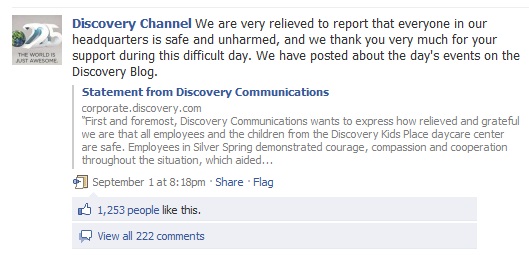 When a gunman took three hostages at Discovery Communications headquarters (home of the Discovery Channel) on September 1, 2010, hundreds of news outlets reported the crisis.
When a gunman took three hostages at Discovery Communications headquarters (home of the Discovery Channel) on September 1, 2010, hundreds of news outlets reported the crisis.
Yet mainstream media was not the first to break the story. An employee inside the Silver Spring, Maryland facility took a photo of an armed law enforcement official using a mobile phone and posted it on Twitpic.

From this one “citizen journalist,” Twitter's viral power took over. Within seconds, people were learning about the ordeal for the first time through the micro-blogging site. Before long, the “Discovery Channel building” became the top trending topic with “Gunman” not far behind.
That was just the beginning. The rest of the day and evening, employees largely chose social media to let their families, friends and fans know they were safe. Likewise, those families, friends and fans commented back by the thousands on Twitter, Facebook and the company's blog.
“With a combination of corporate blogging and then using platforms to push the message out, we reached so many more people,” said Gayle Weiswasser, vice president, social media communications. “It's a much more personal way to engage with and communicate directly with our fans. In a crisis situation, the speed and virality of social media just can't be paralleled.”
Freezing Corporate Social Media
Working with the police, Discovery Communications quickly evacuated 100 children in the onsite daycare center and 1,900 employees minus the hostages. Hours later, the hostage standoff ended with all employees safe when police shot and killed the gunman.
Throughout the crisis, the communications team at Discovery carefully considered how to communicate with the public. They very deliberately chose not to post anything from corporate Twitter, Facebook and blog accounts.
“We were dealing with an irrational actor and a volatile situation, and we didn't know if he was consulting any kind of online sources,” Weiswasser said. “We didn't know what would provoke him further, so we wanted to be completely quiet across any official platforms.”
Social Media Handles and Stats:
Website: http://corporate.discovery.com
All network Twitter accounts: over one million
All Discovery network Facebook pages: 16.3 million fans
Get World-Class Marketing Training — All Year Long!
Are you facing doubt, uncertainty, or overwhelm? The Social Media Marketing Society can help.
Each month, you’ll receive training from trusted marketing experts, covering everything from AI to organic social marketing. When you join, you’ll also get immediate access to:
- A library of 100+ marketing trainings
- A community of like-minded marketers
- Monthly online community meetups
- Relevant news and trends updates
All Discovery network YouTube subscribers: 800,000
Highlights:
- Discovery chose not to post on corporate social media accounts until the crisis was resolved. However, the company let employees inform their fans and followers that they were safe.
- 50,000 viewed the company's blog statement in two days.
- Discovery reached employees and the public with news of the end of the standoff faster than traditional media could.
Free Rein for Employees
Meanwhile, Discovery Communications specifically chose to let employees tweet and post as they desired after evacuation. Thousands of tweets and Facebook status updates went out from employees about their whereabouts, safety and the safety of the children in daycare.
“People were posting once they had evacuated,” Weiswasser said. “We didn't want to hinder that. Social media is the way people communicate today.”

Discover Proven Marketing Strategies and Tips
Want to go even deeper with your marketing? Check out the Social Media Marketing Podcast! Publishing weekly since 2012, the Social Media Marketing Podcast helps you navigate the constantly changing marketing jungle, with expert interviews from marketing pros.
But don’t let the name fool you. This show is about a lot more than just social media marketing. With over 600 episodes and millions of downloads each year, this show has been a trusted source for marketers for well over a decade.
“There was a lot of anecdotal evidence of people saying, ‘I saw your tweet and knew you were OK,'” she added.

50,000 Blog Visits
After the hostages were free, Discovery collected all the facts before crafting an official statement on its blog thanking law enforcement officers and everyone for their concern.
Then, they pushed links to that message out through Discovery corporate Facebook and Twitter accounts, as well as accounts for specific Discovery networks and shows.
“We really wanted to address people who had expressed their concern,” Weiswasser said.
Later, one of the hostages also posted his words of thanks on the corporate blog.
More than 50,000 people responded with visits to the main blog post in just two days, compared to 23,000 blog hits the preceding three months. About 19,000 of those visits came from Twitter, where thousands retweeted and posted @ replies.
“People were tweeting about it so quickly that it was spreading the story faster than traditional media could get to it,” Weiswasser said. “It was a good lesson in how powerful social media is in spreading information.”

It was a level of direct interaction not possible just 5 or 10 years ago. Back then, Discovery Communications' likely response would have been a press release – a one-directional message for the news media.
Instead, Discovery and its audience interacted with two-way dialogue on the blog, Twitter and Facebook. And the important announcement about the end of the crisis reached the public and employees faster than through traditional media.
“Never underestimate the audience for something like this and feed that audience as quickly as you can without compromising safety,” said Weiswasser. “Social media provided a very efficient and quick way to deliver a personal message to the community very quickly.”

No rogue posting – In a crisis, social media should follow in lockstep with your corporate communications plan. At Discovery, it meant corporate social media waited until the company was ready to make an official statement.
Tell your people – Give your audience – in this case, employees and the public – an official message as soon as you safely can. “Even we were surprised by the volume of interest in the content we were posting.” Weiswasser said.
Tap into the viral effect – Social media tools such as blogging, Twitter and Facebook all working together provided the fastest way to inform the greatest number of people.
Does your company have a crisis communications plan in place? How does social media fit in? Any firsthand experiences of social media helping preserve your personal safety? Let us know your comments in the box below.
Attention Agency Owners, Brand Marketers, and Consultants

Introducing the Marketing Agency Show–our newest podcast designed to explore the struggles of agency marketers.
Join show host and agency owner, Brooke Sellas, as she interviews agency marketers and digs deep into their biggest challenges. Explore topics like navigating rough economic times, leveraging AI, service diversification, client acquisition, and much more.
Just pull up your favorite podcast app, search for Marketing Agency Show and start listening. Or click the button below for more information.

